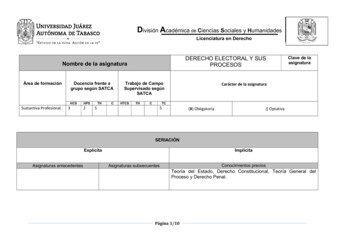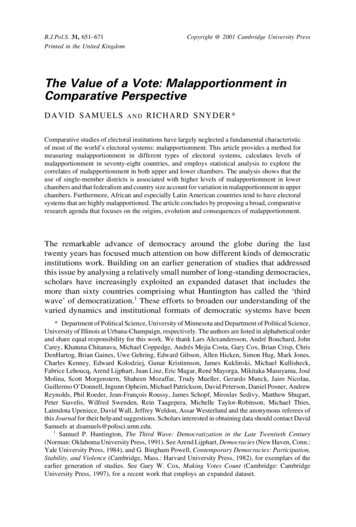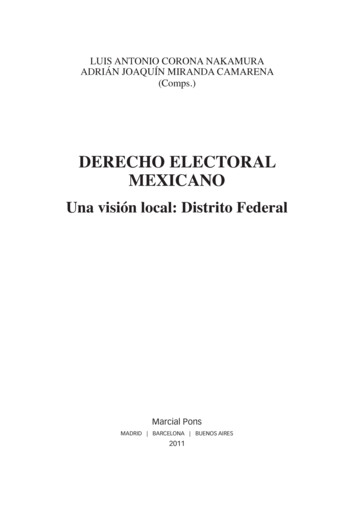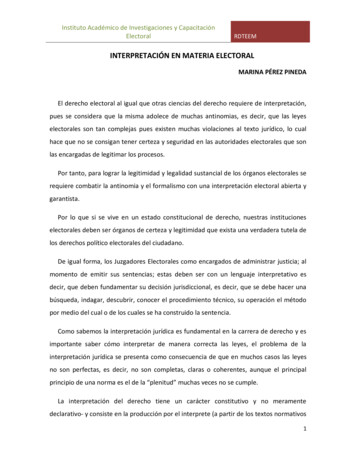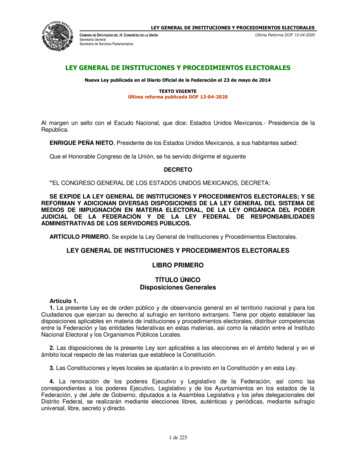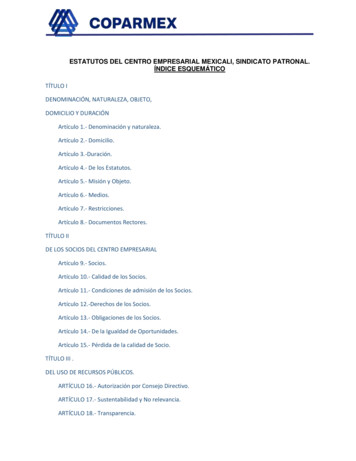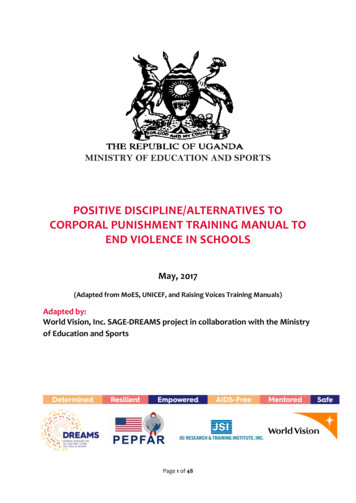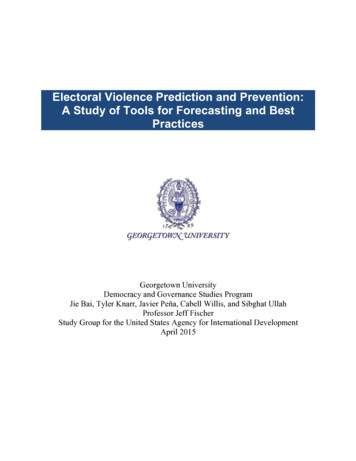
Transcription
Electoral Violence Prediction and Prevention:A Study of Tools for Forecasting and BestPracticesGeorgetown UniversityDemocracy and Governance Studies ProgramJie Bai, Tyler Knarr, Javier Peña, Cabell Willis, and Sibghat UllahProfessor Jeff FischerStudy Group for the United States Agency for International DevelopmentApril 2015
2Georgetown University Electoral Policy Study GroupsThe Georgetown Electoral Policy Study Groups are an initiative of the Georgetown UniversityDemocracy and Governance Studies Program and the United States Agency for InternationalDevelopment, bringing together students to work with and learn from experienced scholars,policymakers, and practitioners in the field of electoral studies. In cooperation with the UnitedStates Agency for International Development’s Center of Excellence on Democracy, HumanRights, and Governance, students in the Electoral Policy Study Groups research and engagecontemporary dimensions of and challenges to elections around the world, such as electoralviolence and electoral integrity.
3AcknowledgmentsThis report presents the research of students in Georgetown University Master in Democracy andGovernance Studies Program conducted under the direction of Professor Jeff Fischer. Theopinions and observations expressed here are those of the authors and do not represent the viewsof Georgetown University, the Democracy and Governance Studies Program, or the UnitedStates Agency for International Development (USAID).The authors are grateful to the Democracy and Governance Studies Program for organizing theopportunity to gain the valuable research experience and that was made available through thisproject. The authors also wish to recognize and thank the Center of Excellence on Democracy,Human Rights and Governance at USAID, and Tess McEnery and Matthew Grieger inparticular, for their enthusiastic support of and partnership with this project and for giving us theopportunity to present our findings at the DRG Center. In addition, the authors wish to expresstheir gratefulness to Luther Jeke at Creative Associates International, who provided valuableinformation and resources about social media tools as well as assistance in the creation of theelectoral violence map.Finally, the authors wish to express their deep appreciation and gratefulness to Professor Fischer,who made himself available to provide constant guidance and comments throughout the entireproject. His dedication to the issue of electoral violence and generosity in sharing his experienceand expertise is a tremendous asset to the Democracy and Governance Studies Program. Thisendeavor would not have been possible without him.
CSANDFSSAUNDPUSAIDQRFArtificial Intelligence for Disaster ResponseArtificial Intelligence for Monitoring ElectionsAwami LeagueAfghan Local PoliceAfghan National Department of SecurityBangladesh National PartyIndian Election CommissionElectoral Institute for Sustainable Democracy in AfricaElectoral Risk ManagementArmed Islamist GroupInformation and Communication TechnologyInternational Institute for Democracy and Electoral AssistanceIndependent Directorate of Local GovernanceIndependent Election CommissionIndependent Electoral Complaints CommissionIndian Penal CodeInternational Security Assistance ForceIntegrated Predictive Framework for Electoral ViolenceJoint Operational and Intelligence StructureMinistry of DefenseMinistry of InteriorNational Liberation FrontAfrican Party for the Independence of Guinea and Cape VerdeAlgerian People’s National ArmyProvincial Coordination CenterRegional Coordination CenterSouth African National Defense ForcesState Security AgencyUnited Nations Development ProgrammeUnited States Agency for International DevelopmentQuick Reaction Forces
5Table of ContentsAcknowledgements.3Acronyms.4Executive Summary.6Section One: Strengthening Predictive Frameworks for Electoral Violence .8Section Two: Best Practices for Violence Prevention in Elections .26Global Survey of Electoral Violence in 2014.34
6Executive SummaryThis report evaluates and strengthens methodologies for predicting and best practices forpreventing and addressing electoral violence based on the USAID Electoral Security Frameworkand Best Practices in Electoral Security.The report includes three sections: a database of incidents of electoral violence in 2014, a sectionon strengthening predictive frameworks for electoral violence, and a section investigating bestpractices for preventing electoral violence.The final section presents the Global Survey of Electoral Violence in 2014, which consists of adatabase of incidents of electoral violence in 2014 based on a survey of those incidentsconducted by the researchers. The database presents the data in a simplified list format within thereport itself and in a detailed excel table (attached separately). A color-coded map illustrating theintensity of electoral violence where it occurred accompanies the database.The first section of this report presents a survey and comparative evaluation of existingmethodologies for predicting and risk factors associated with electoral violence. This evaluationcompared the risk factors outlined the USAID Electoral Security Framework with those specifiedby the United Nations Development Programme (UNDP) Conditions and Risk EvaluationApproach and the International Institute for Democracy and Electoral Assistance (IDEA)Electoral Risk Management (ERM) Tool.From the comparative evaluation of these frameworks for predicting electoral violence, thissection develops and details an Integrated Predictive Framework for Electoral Violence (ipFEV).This Integrated Framework builds upon the structural and election-specific risk factors outlinedin the USAID Electoral Security Framework, incorporating the political and security contextsurrounding an election as specified by the UNDP framework and the distinction betweenstructural risk factors internal to an election and those external to an election based on thedistinction between internal and external factors highlighted in the IDEA ERM Tool. IpFEVemphasizes the overlooked importance of external structural factors in predicting electoralviolence. Additionally, the Integrated Framework evaluates the increasing potential of socialmedia as a tool for predicting electoral violence.Based on data in the 2014 Global Survey of Electoral Violence, the evaluation of predictivemethodologies applies ipFEV to the cases of Guinea-Bissau, Bangladesh, and Algeria in order toidentify the salient risk factors present in those cases. Based on the examination of these caseswe argue the following: first, the risk factors identified in the USAID Electoral SecurityFramework remain highly relevant for predicting electoral violence in a variety of contexts.Second, across all cases, the political and security context remains an important overarchingfactor for identifying electoral violence risk: countries in which the political and security contextdemonstrates a Country in Transition and Post-War Society are particularly vulnerable toelectoral violence. Third, Structural risk factors external to an election are also significantpredictors of electoral violence, in that they set the specific preconditions for such violence.Key to the findings of the predictive methodologies section is the argument that External,Structural factors in a society often overshadow and lie at the root of electoral violence. Effective
7prediction of electoral violence begins with identification of these factors and their root causeswithin a given political and security context. The identification of an overarching political andsecurity context and the distinction between Internal and External Structural factors that ipFEVprovides are thus fundamental to the prediction of electoral violence.The second section of this report elaborates the research on enhancing the current USAID bestpractices framework for preventing electoral violence. This section begins with an overview ofthe methodology used to conduct this research. The three cases chosen to inform this researchwere India, Afghanistan, and South Africa. These states were chosen because they face dynamicand consistent election violence challenges while demonstrating the capacity to innovate anddevelop responses to this election violence. They were also chosen because they varied incontext and interventions used.Using these examples as case studies we then provide conclusions drawn and give suggestionsfor how USAID’s current framework could be enhanced. Our conclusions fall under two maincategories: New Framework dimensions and strategic combinations.First, we argue that technology should exist as its own dimension under the electoral cyclecomponent of the USAID framework. Technological developments such as drones, cell phonesor hotlines for reporting and the use of social media tracking have proven to be influential acrossnumerous cases for predicting, preventing and reacting to electoral violence. Second, wedemonstrate why we believe security force dispersal should be included as a new frameworkdimension within the election phase component.Next we discuss how the inclusion of Strategic Combinations could enhance the currentframework. A strategic combination refers to the use of two or more interventions or addressingtwo or more issues in a way that produces a better outcome or prevention method. We providespecific examples from the research that illustrate effective strategic combinations.There is no question that USAID produces some of the most contemporary and influentialliterature on election violence prevention, however, by including these dimensions newdimensions of technology and force dispersal as well as covering how interventions can bestrategically utilized in ways to make them more effective, the framework would be enhanced.
8Section One: Strengthening Predictive Frameworks for Electoral ViolenceIntroductionThis study identifies risk factors for electoral violence and evaluates the effectiveness ofmethodologies for predicting violence based on these risk factors. The evaluation focusesspecifically on the risk factors outlined in the United States Agency for InternationalDevelopment (USAID) Electoral Security Framework in the comparative context of two otherpredictive approaches to profiling electoral violence: the United Nations DevelopmentProgramme (UNDP) Conditions and Risk Evaluation Approach and the International Institute forDemocracy and Electoral Assistance (IDEA) Electoral Risk Management (ERM) tool.The current USAID Electoral Security Framework identifies “historical conflict,” “structural,”and “election-specific” risk factors that have the potential to contribute to electoral violence. Inevaluating the USAID Framework, our study asks four fundamental questions: First, is there acorrelation between the USAID-identified risk factors and actual incidents of electoral violence?Second, which USAID-identified risk factors demonstrated the strongest correlation and whichrisk factors demonstrated the weakest correlation with actual incidents of electoral violence in2014? Third, which risk factors were more prominent or less prominent in contributing toelectoral violence during each phase of the electoral cycle? Finally, what risk factors thatcontributed to actual incidents of electoral violence does the USAID Framework omit?Through a comparative evaluation of the aforementioned predictive approaches, this study aimsto assist researchers and practitioners to modify, strengthen, and apply existing predictivemethodologies to help prevent and more effectively address future instances of electoralviolence.Objectives and MethodologyThis study defines electoral violence as any act of violence with the specific intent of disruptingthe process and outcome of an election. Electoral violence may occur during any given phase ofan election cycle: pre-election, election day, or post-election. The research for this studyconsiders incidents of electoral violence that occurred across the world in 2014. Based on reportsof these incidents, we have sorted the incidents by type and intensity of electoral violence, typeof victim and type of perpetrator, and the phase of the electoral cycle in which the violenceoccurred. To measure intensity of violence, this study applies Straus and Taylor’s intensity ofviolence scale.1 The Incidents of Electoral Violence in 2014 report provides a database of thisinformation.The objective of this study is to isolate and identify significant correlations between specific riskfactors and specific types and intensities of violence; violence enacted by certain types ofperpetrators; violence enacted on certain types of victims; and violence enacted during specificphases of an electoral cycle. By identifying the varying prominence of certain risk factors in the1Scott Straus and Charlie Taylor, Democratization and Electoral Violence in Sub-Saharan Africa – 1990 – 2007,University of Wisconsin, ct id 1451561
9context of specific manifestations of electoral violence, this research assigns relative weight(significance) to various risk factors for predicting incidents of electoral violence in variouscontexts. As we will explain below, we weigh risk factors depending on their context.In order to achieve these research objectives, this study has developed an expanded electoralsecurity assessment framework, which we will call the Integrated Predictive Framework forElectoral Violence (ipFEV). This “Integrated Framework” builds upon the structural andelection-specific risk factors outlined in USAID Electoral Security Framework, applying riskfactors outlined in the UNDP Conditions and Risk Evaluation Approach and the IDEA ERMtool. In considering these other predictive approaches to electoral violence, including theapplication of social media monitoring methods, ipFEV provides a strengthened and moreholistic approach to predicting electoral violence in the twenty-first century. First, ipFEVidentifies the overarching political and security context related to democratization, similar to theUNDP Approach. Second, drawing on the IDEA ERM Tool’s distinction between internal andexternal factors, ipFEV identifies structural (including historical conflict) and election-specificUSAID-identified risk factors as internal or external to electoral violence. Through a criticalexamination of the pathway to democracy, ipFEV applies UNDP’s contextual perspective tosituate these factors in their relevant political environments in order to better identify their rootcauses. By first identifying countries that have “consolidated” or are successfully striving toconsolidate democracy, and distinguishing between risk factors as internal or external to anelection, practitioners may more effectively develop and tailor their responses to preemptivelyaddress the challenges to electoral security.The research for this study applies ipFEV to documented incidents of electoral violence in threecountries: Guinea-Bissau, Bangladesh, and Algeria. We chose these cases as each country washome to an election in 2014 that reflected a different level of intensity of electoral violence andeach election reflected a variety of types of violence, including the disruption of the electoralprocess by youth in Algeria. A detailed comparative case analysis of these countries identifiesthe type and intensity of incidents of electoral violence that occurred in 2014, the perpetratorsand victims of these incidents, and the phases of the electoral cycle in which these incidentsoccurred. The case analysis of each country considers the predominant risk factors correlatedwith each incident in accordance with the risk factors outlined in ipFEV. This analysis revealswhich risk factors are more salient in each case, and thus, should be more heavily weighted forpredicting electoral violence in various contexts.Based on these findings, this report evaluates and strengthens the effectiveness of the predictivemethodologies of the USAID Electoral Security Framework by suggesting specific modificationsto the weight and structure of risk factors for and indicators of electoral violence in variouscontexts.Existing Electoral Security Assessment FrameworksUSAID Electoral Security Framework22Jeff Fischer, Karen Kaplan, and Elisabeth Bond, “Electoral Security Framework: Technical Guidance Handbookfor Democracy and Governance Officers,” July 2010, /1866/1Electoral-Security-Framework.pdf
10As previously mentioned, the USAID Electoral Security Framework distinguishes between“historical conflict,” “structural,” and “election-specific” risk factors.I. Historical Conflict FactorsHistorical factors are the most prominent in shaping the environment and context in which anelection and electoral violence may occur. Historical conflict factors may be “election-specific,”insofar as they reflect a specific history of electoral violence. Such specific histories of electoralviolence may serve as predictors for the occurrence and features of future violence, includingvictims, perpetrators, types and intensities of violence, and locations of violence. Historicalconflict factors may also refer to a general history of conflict that contributes to a risk forelection violence in a given country.II. Structural FactorsStructural, or contextual, risk factors are those vulnerabilities that exist outside of the directelectoral context, constitute the basic environment for elections, and create conditions forelectoral conflict to occur. Structural risk factors include: Security, political, economic, andsocial factors.Security risk factors reflect the training, equipment, support, and politicization of security forces,as well as the rules of engagement governing those security forces. Additionally, post-conflictpolitical environments, the availability of firearms, crime rates, and the presence of PrivateArmed Groups, militias, and on-going insurgencies are all potential security risk factors.Political risk factors generally include the type of regime and style of governance, as well as thelegal framework guiding the electoral process, the structure and function of the political financesystem, and the normative and established practices and behaviors of campaigning.Economic risk factors potentially contributing to electoral violence include per capita income,the distribution of wealth (as measured by the GINI coefficient), and Gross Domestic Product.Social risk factors for electoral violence include established social cleavages in a country, suchas ethnic, religious, linguistic, and regional division. Additionally, demographic shifts, such asimmigration, displacement, urbanization, and a swollen population of unemployed youth are alsoprominent social risk factors. Finally, the role of elites in the election process is another socialrisk factor that may lead to election violence.III. Election-Specific FactorsElection-specific factors are internal vulnerabilities that are directly related to electoral actors,events, practices and materials that can trigger or contribute to triggering election-related conflictin a given time or place. Election-specific risk factors include: the type and structure of theelectoral system and the party system, the quality of electoral dispute adjudication mechanisms,the independence of the electoral monitoring board, the timing and sequencing of the election,the delimitation and decentralization of election districts, the risk of election fraud, legislativereforms made prior to the election, boycotts, general political confrontations, hate-speech,propaganda, rumors and misinformation, as well as social media influences.
11UNDP Conditions and Risk Evaluation Approach3The UNDP Conditions and Risk Evaluation Approach takes a broader perspective in comparisonwith the USAID Electoral Security Framework, identifying overarching vulnerabilitiesassociated with a country’s degree of democratization. The UNDP Approach thus considers thecontext and pathways of democratization, as well as the dynamics of the electoral system and thedynamic of conflict in a given country. Degrees or stages of democratization are identifiedaccording to Countries in Transition, Consolidating Democracies, and Post-War Societies.“Countries in Transition” include those under authoritarian or single-party rule, while“Consolidating Democracies” include states that have undergone transitions in which the futurepolitical regime remains fragile and uncertain. These ideal types of the “Transition Paradigm,”however, assume a questionable inevitability of transition, which can be problematic forpredicting and addressing electoral violence.4The dynamics of the electoral system and the dynamics of conflict reflect the structure of theelectoral system, the formula of the election process, the size of districts, the ratio between votesand seats of representation, the delimitation of boundaries, the structure of political parties, thecampaign appeal strategies of candidates, and the overall character of the political contest.At the root of these vulnerabilities are “root causes,” including economic and political stakes,expectations of winning, and incentives to commit violence.IDEA ERM Tool5The IDEA Election Risk Management Tool considers whether risk factors for electoral violenceare internal or external factors. Internal factors are election specific and do not exist outside ofthe specific context of a particular election. These factors relate to electoral actors, events,practices, and materials which may trigger or contribute to the triggering of election-relatedconflict in a given time or place. Internal factors include the electoral legal framework, theplanning of an election, training and information related to the election, the electoral registrationprocess, campaigning, the operation of voting, and the verification of election results.External factors, existing beyond the specific context of an election, create the conditions forelectoral conflict to occur. These factors include socio-economic conditions, social and politicalexclusion, changing power dynamics in a society, and gender-based discrimination and violence.The presence of non-state armed actors or organized crime that undermine a state’s monopoly onthe legitimate use of violence also comprise External risk factors. Moreover, genocide, crimesagainst humanity, war crimes, and general violations of human rights, environmental hazards,and unethical media reporting are risk factors external to an election that may precipitateviolence.3“Elections and Conflict Prevention: A Guide to Analysis, Planning, and Programming,” UN DevelopmentProgramme, guide/Elections-Conflict-Prevention.pdf.4Thomas Carothers, “The End of the Transition Paradigm,” Journal of Democracy 13 (2002): 5-21.5“Electoral Risk Management Tool,” International IDEA, last updated March 10, 2015,http://www.idea.int/elections/ermtool/.
12Integrated Predictive Framework for Electoral Violence (ipFEV)Although USAID’s Framework demonstrates effectiveness in predicting and evaluating electoralviolence in theory and, as we shall see, in practice, the other two frameworks provide valuableinsights for the same. The UNDP and IDEA frameworks complement the USAID frameworkbecause they address electoral violence specifically. As previously mentioned, the mainobjective of this study is to further strengthen the USAID Framework. The Integrated PredictiveFramework for Electoral Violence is primarily based on the USAID Framework, but also drawsupon the UNDP Conditions and Risk Evaluation Approach and the International IDEAERM Tool for comparative purposes. In order to develop an improved methodology, we arebuilding upon and synthesizing the best of each of these methodologies.Drawing from the methodology of the UNDP Approach, ipFEV identifies overarching politicaland security context vulnerabilities related to the democratization of a given country. However,identifying the specific risk factors within an election is integral to identifying the overarchingpolitical vulnerability of a country to electoral violence. Thus, while the identification of thespecific risk factors for electoral violence is the identification of the problem, per se, consideringthem collectively in the degree to which they reflect a larger overarching political vulnerability isnecessary to identify and address the “root causes” of electoral violence that may need to beaddressed in a broader context. Such an overarching political vulnerability especially includesunconsolidated and illiberal democracies and electoral authoritarian regimes, in which electionsare either absent, not free and fair, fail to reflect the will of the people, or have little to no realpolitical import. The ipFEV categories for political pathways that reflect overarching politicaland security context vulnerabilities draw directly from the UNDP-identified categories for thecontext and pathways of democratization, and include: Countries in Transition, ConsolidatingDemocracies, Post-War Societies, and Countries with Pending Referendums andAgreements. We have outlined these categories in greater detail below.The other of the aspects of the UNDP-identified overarching vulnerabilities, including thedynamics of an electoral system and the dynamics of conflict in a given country, fit moreappropriately with the Internal and External Structural risk factors, respectively, as outlinedhereafter. The political and security context of a given country, however, is an importantoverarching factor that determines the risk of electoral violence in that country. The extent ofdemocratization, for example, may determine the overall risk for electoral violence in a country,as well as the presence and manifestation of other, more specific risk factors. Thus, the politicaland security context determines the relative weight of each category of risk factors, as we willexplain in greater detail after introducing the different categories of factors. The identification ofoverarching vulnerabilities in a political and security context, while essential for a preliminarycontextual evaluation of the risk of electoral violence in a country, must, by nature, follow theidentification of specific risk factors: in order to understand the complete picture, it is necessaryto first have and assemble all the pieces of the puzzle.To identify the pieces of the puzzle, ipFEV employs the IDEA perspective of Internal andExternal factors to further specify the USAID-identified risk factors for electoral violence. Likethe USAID framework, ipFEV distinguishes between “structural,” and “election-specific”factors. Notably, ipFEV incorporates “historical conflict” factors into the broader category ofstructural factors. History, as the USAID framework indicates, is the most prominent factor inshaping the environment and context in which an election and electoral violence may occur.
13Contextually, the history of a country is integral to the shaping of the structural context in whichan election occurs. A history of electoral violence may predict the occurrence and features offuture violence. Specifically, a history of electoral violence may identify victims, perpetrators,types, and intensities of violence, and locations of violence throughout former elections,indicating that future elections may reflect the same features.IpFEV further specifies the USAID-identified structural and election-specific factors as“external” or “internal” to an election in accordance with the IDEA ERM Tool. As previouslystated, external factors, existing beyond the specific context of an election, create the conditionsfor electoral conflict to occur. Internal factors are election specific and do not exist outside of thespecific context of a particular election. These factors relate to electoral actors, events, practices,and materials which may trigger or contribute to the triggering of election-related conflict in agiven time or place.Considering these distinctions, ipFEV has three categories of risk factors for electoral violence:External Structural risk factors, Internal Structural risk factors, and Internal ElectionSpecific risk factors. The tables in this section outline these risk factor categories. Finally, underthe category of Internal Election-Specific factors, ipFEV examines more closely and in greaterdepth the potential of social media as predictor of electoral violence.The weight of these factors varies depending on the overarching political and security context ofthe country. In cases where the political and security context reflects a Country in Transition, aPost-War Society, or even a Consolidating Democracy, External Structural risk factors may bemore accurate predictors of the electoral violence insofar as they reflect root causes of thatviolence. In Consolidating democracies, however, Internal Structural risk factors and ElectionSpecific risk factors may also more accurately reflect the causes of electoral violence. This is notto say that in any given case, one category of factors eclipses all others in importance; rather, in
report itself and in a detailed excel table (attached separately). A color-coded map illustrating the intensity of electoral violence where it occurred accompanies the database. The first section of this report presents a survey and comparative evaluation of existing methodologies for predicting and risk factors associated with electoral violence.


